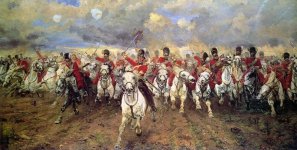TangoTwoBravo
Army.ca Veteran
- Reaction score
- 2,741
- Points
- 1,110
It can be useful to settle on some terms.Terminology Clarification Question: I was under the understanding that Canada has Armour, not Cavalry.
Cavalry AFAIK is an American term. Though with research there seems to be an argument that Cavalry refers to a type/style of armor employment.
Are the terms interchangeable or should we be using Armour in the RCAC context?
I know it seems pedantic but the terminology can be confusing.
My own background as an Armour officer includes both tank and reconnaissance. I have been a Recce Sqn BC/2IC on operations and a Recce Sqn OC for two years in Canada. My Recce Sqn had two armoured recce troops, an infantry recce platoon and a sniper platoon. I was also the DCO of a Recce Regt BG for two Maple Resolves (well, for one were a Port Au Prince Guard Mech BG but anyhoo). I am also a graduate of the US Army Cavalry Leader's Course. My turret time expires, though, sometime around 2013!
The US Army employs the term Cavalry. It can can have purely historic reasons (1st Cavalry Division for example) with no reference to role. The role of US Cavalry organizations is to protect and preserve the fighting ability of other combined arms forces. While its primary missions are reconnaissance and security, the cavalry troop may be called upon to execute attack, defend and delay missions as part of squadron (unit sized) and regimental (brigade sized) missions. The Troop accomplishes its missions by communicating, moving and shooting in that order. The emotional touch-stone for US Cavalry is Buford at Gettysburg.
US Cavalry organizations are mixed. There are scout platoons and tank or anti-tank platoons. There is usually integral fire support at the sub-unit level. The Scout Platoons seek to employ stealth to accomplish their tasks. The tank platoons follow and fight as required to accomplish the mission. You can absolutely employ stealth with a Coyote or a LAV. By stealth/sneak and peek I mean using the terrain to mask movement and avoiding getting ambushed with ease by the enemy. US Scout platoons have dismounts - they are not infantry. They are scouts.
US Cavalry organizations can Screen and Guard supported formations generally within their own means with the exception of real fire support. They can also Cover at Regimental level.
Screen: To protect the main body of a force by providing early warning. This is a bread and butter security task and can be conducted as part of offensive, defensive and transitional operations. So a screen detects the enemy in time for the supported formation to react accordingly. My analogy I used at the College was that a Screen is similar to a ball carrier in football seeing a potential tackler in time to alter his course. In US doctrine Screen has the implied task of destroying enemy reconnaissance - we lack such a codicil. A screen supporting a brigade in the defence may well be an OP line with a variety of mounted and dismounted OPs. A screen in front of an advance would generally be a zone or area reconnaissance.
Guard: To protect the main body of a force through the application of combat power while also observing and reporting. The guard will provide more than just warning, it will fight to protect the enemy interfering with the main body/guarded force. Barring other arrangements, a Guard will operate within the fire support of the supported formation. A Guard is like the ball carrier employing a stiff-arm to stop or deflect an tackler to allow him to make adjustments.
Cover: To protect the main body of a force by engaging an enemy while also observing and reporting. The difference from a Guard is that a covering force operates apart from the main force. It is self-contained - an US Armored Cavalry Regiment would Cover. A Cover is like having another player prevent tacklers from reaching the ball carrier. Yes - the analogy is starting to stretch.
What does all this mean? In Canadian doctrine armoured reconnaissance could absolutely Screen. Coyotes, LAVs and indeed TAPVs can Screen whether on the offence or defence. A Canadian armoured reconnaissance squadron could form part of a Guard (say a BG with a Recce Sqn attached) or with significant attachments it could contemplate a Guard task. Could adding ATGMs to LAV-Recce and TAPV allow a recce squadron or rebranded Cavalry squadron the ability to guard, or to think about operating as a US Cavalry organization? Perhaps. It would certainly make the destruction of enemy recce elements easier. They could think about fighting to buy time. I would prefer, though, to have some sub-sub units as scouts and others as shooters.
I believe that the current initiative about rebranding to Cavalry is about having a common occupational structure, as well as a common organization and some tactics for all armour elements. So a Cavalry Squadron could be Heavy and have four Troops of four tanks each, or it could be Light with four troops of four LAV-Recce each. This would mean some definite adjustments to Recce tactics in terms of patrols etc, but I think that it would be transparent to supported formations. An infantry BG might have a Heavy Cavalry Squadron attached that would look suspiciously like a current tank squadron. Perhaps the Brigade would have a Light Cavalry Squadron conducting security tasks (screening) that would have the same effect as the Brigade Recce Sqn. In theory you could put them together under one BG CO and conduct something akin to US Cavalry tasks but we can do that now with the right groupings. Perhaps a light infantry battalion receives a Light Cavalry Squadron in TAPVs that executes a wide variety of tasks, ranging from screens to direct fire support?
I believe that the payoff is making it easier to have people transition between the roles if we find ourselves in rotational warfare again.




